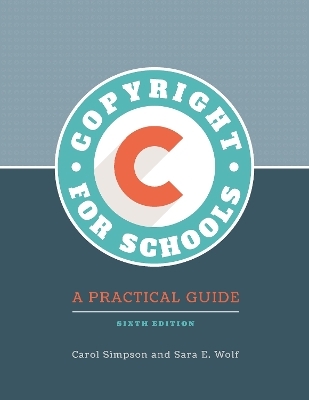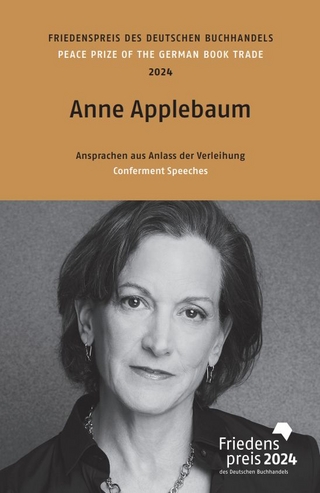
Copyright for Schools
Libraries Unlimited Inc (Verlag)
978-1-4408-6483-4 (ISBN)
This updated edition of Copyright for Schools explains U.S. copyright law as it applies to education settings clearly and concisely for teachers and school librarians.
Topics new to this edition include copyright implications related to the use of such streaming services as Netflix™ and Pandora™, links to online tools that teachers can use to assist them in making their own daily decisions regarding the use of copyrighted materials, and implications relating to the use of anonymous internet publishing tools such as Snapchat™ and use of Cloud-based sharing. Other new topics include issues related to disability, how to appropriately respond to cease and desist letters and other legal inquiries, implications of the Music Modernization Act, and expanded discussion of open resources such as Creative Commons licenses.
This edition also adds a concordance in a "Scope and Sequence" table format, so all information related to U.S. copyright knowledge is accessible no matter where it resides within the text, and provides links to online tools and resources that can be used to guide users of copyrighted materials in making decisions about how to use them. Still included are the real-world applications and the Q&A sidebars from prior editions.
Carol Simpson is a practicing attorney, retired associate professor of library and information science, and former school librarian, teacher, and district library administrator. Sara E. Wolf is an associate professor at Auburn University. Her interest in copyright began more than 25 years ago and has grown to include speaking, teaching, and institutional policy development activities.
Illustrations
Acknowledgments
Introduction to the Sixth Edition
Chapter 1: The Law
History
Origin in the United States
What It Is Now
Rights of a Copyright Holder
Reproduction
Adaptation
Distribution
Limitation on Right of Distribution: First Sale Doctrine
Public Performance
What Is "Public"
Public Display
Digital Transmission of Sound Recordings
Moral Rights
Enter Fair Use
How Does One Get a Copyright?
What Can't Be Protected by Copyright?
Work for Hire
Ideas
Duration of Copyright
Protected or Not?
Registering a Work
Recent Laws
No Electronic Theft (NET) Act
Visual Artists Rights Act (VARA)
Digital Millennium Copyright Act (DMCA)
Sonny Bono Copyright Term Extension Act
Digital Performance Right in Sound Recordings Act
Technology, Education and Copyright Harmonization Act (TEACH Act)
Family Entertainment and Copyright Act
Orrin G. Hatch–Bob Goodlatte Music Modernization Act (MMA)
Marrakesh Treaty Implementation Act (MTIA)
Penalties for Infringement
Liability
State Copyright Laws
Related Laws
Contract Law
Privacy Statutes
Trademark Law
Trade Secret Law
Why Is Any of This Significant for Schools?
How Is a School Sued?
What If There Is No Trial?
Why Worry, Why Bother?
Works Cited
Chapter 2: Public Domain
What Is It?
How Does Something Get into the Public Domain?
How Long Does Public Domain Last?
What Can You Do with Public Domain Materials?
How Do You Find Public Domain Materials?
Works Cited
Chapter 3: Licensed and Royalty-Free Materials
How Do "Copyright Free," "Royalty Free," "License," and "Lease" Differ?
How Can I Use Royalty-Free Materials?
Licenses for Royalty-Free Materials: Creative Commons
Some Other Open Source Licensing Options
Open Access versus Open Educational Resources
What Entities Do NOT Allow Royalty-Free Access to Materials
Sources of Royalty-Free Materials
Works Cited
Chapter 4: Fair Use
What Is It?
Difference between Statutory Fair Use and Guidelines
Examples of Fair Use Analysis
Factor One: Purpose and Character of Use
Factor One, Part 1: Nonprofit Educational Use
Factor One, Part 2: Criticism, Commentary, or News Reporting
Factor One, Hidden Issue: Transformativeness
Factor One, Hidden Issue: Bad Faith
Factor Two: Nature of Copyrighted Work
Factor Two, Part 1: Factual or Creative?
Factor Two, Part 2: Published or Not Published?
Factor Three: Amount of Work Used?
Factor Three, Hidden Issue: Essence of Work
Factor Four: Effect of Use on Market for or Value of Work
Factor Four: Commercial Use
Factor Four, Hidden Issue: Misrepresentation
What Would Happen if Everyone Were to…
Various Types of Guidelines
To Whom Does It Apply?
Schools versus Libraries
Works Cited
Chapter 5: Print Materials in Schools
What Typical Activities Are Covered?
Photocopying—Issues
Phonorecords—Issues
Graphics—Issues
A Graphics Case in Point
Murals—Issues
Scanning—Issues
What Rights Are Affected?
Reproduction
Distribution
Adaptation
Display
What Guidelines Affect Print Materials?
Kastenmeier Report
Details of Report
Single Copies for Teachers
Multiple Copies for Classroom Use
Brevity
Spontaneity
Cumulative Effect
Examples of Acceptable Multiple Copying
Examples of Unacceptable Multiple Copying
Print Permission Issues
Consumable Materials
Periodicals
Graphics
Student Work
Scanners
Fair Use Index
Resources for Understanding
Fair Use of Print Materials Glossary
Works Cited
Chapter 6: Audiovisual Materials in Schools
What Typical Activities Are Covered?
Movies—Issues
TV/Cable/Satellite—Issues
Web—Issues
Sound Recordings—Issues
What Rights Are Affected?
Reproduction
Distribution
Adaptation
Public Performance
Public Display
Digital Transmission
What Guidelines Affect AV Materials?
Five Yes/No Questions
Nonprofit Educational
Classroom or Similar Place
Instructors and Pupils in the Course of Face-to-Face Teaching Activities
Legally Acquired Copy
Library
Student or Teacher
Borrowed from Library
Rented Video
CAVEAT 1: Digital Downloads
CAVEAT 2: Streamed Videos
Recorded Off-Air
Face-to-Face Teaching Activities
Umbrella/Blanket Licenses
Home Use Only
Streaming Services
Movie Cautions
Examples of Analysis
Off-Air Recording Guidelines
"Air" versus Cable versus Satellite
Recording in Anticipation
Public Performance Rights
Examples of Acceptable Performances
Examples of Unacceptable Performances
Archiving Audiovisual Works
Video Distribution
Digital Video Servers/Video Streaming Servers
Sound Recordings
Noninstructional Performances of Sound Recordings
Copying Sound Recordings
Sampling
The Digital File Sharing Dilemma
Music Copyright Infringement Resource
Works Cited
Chapter 7: Music Materials in Schools (Print and Recorded)
What Typical Activities Are Covered?
Reproduction of Sheet Music—Issues
Performances of Sheet Music—Issues
Reproduction of Recorded Music—Issues
Performances of Recorded Music—Issues
Adaptation of Sheet Music—Issues
What Guidelines Affect Music?
Print Music
Recorded Music
What Rules/Laws Are Different about Recordings?
Music in Performance
Broadcasting Music
Performance Rights Organizations
Permissions and Licenses
Music for Free?
Background Music
Clip Music
Resources for Understanding
Works Cited
Chapter 8: Multimedia in Schools
What Typical Activities Are Covered?
Student Multimedia Projects—Issues
Teacher Multimedia Projects—Issues
What Rights Are Affected?
Reproduction
Adaptation
Distribution
Public Performance
Public Display
Digital Transmission
What Guidelines Affect Multimedia?
Multimedia Guidelines
Special Definitions for Multimedia
Multimedia—Covered or Not?
Collection or Adaptation?
Collection
Adaptation
Retention and Access
Secure Network
Insecure Network
Quantity Limits
How Many Copies?
Other Restrictions
Attribution
Citing Creative Commons-Licensed Material
Multimedia Tips
Resources for Understanding
Works Cited
Sample Mediography
Chapter 9: Distance Learning in Schools
History of Distance Learning and Copyright
TEACH Act Requirements
Policymakers
Information Technology Staff
Instructors/Developers
Digitizing for Online Learning
Resources for Understanding
Work Cited
Chapter 10: Internet in Schools
What Typical Activities Are Covered?
Printing Pages—Issues
Bookmarks—Issues
Links—Issues
Copying Pages to Local Servers—Issues
Redistributing Pages—Issues
Email—Issues
Chat and Instant Messenger—Issues
Social Media—Issues
Streamed Video/Audio Services (e.g., Netflix or Pandora)—Issues
What Rights Are Affected?
Reproduction
Adaptation
Distribution
Public Performance
Public Display
Digital Transmission
The Difference between an AUP and Copyright
Special Rules for Internet
Designated Agent
Why Is This Important?
How Do We Know That Someone Claims to Own Some Material Mounted on Our Website?
What Guidelines Affect Internet?
Special Considerations for Different Internet Services
Email
Newsgroup, Discussion List, and Other Social Media Information
Web Page Information
Chat
Copying Internet Code
New-Generation Applications
Social Networking
Podcasting
YouTube, Teacher Tube, and Similar Video Sharing Sites
Flickr, Google Photos, Snapfish, Phototheca, and Similar Photo-Sharing Sites
Diigo, Pinterest, StumbleUpon, Reddit, and Other Social Bookmarking Sites
Wikis and Other User-Contributed Online Databases
Kindle and Other E-books/Audiobooks
Blogs, Vlogs, and Other Self-Publishing
Twitter and Other Microblogging Tools
Second Life, MUDs, MOOS, and Other Virtual Worlds
The Cloud—Document/File Sharing
Microsoft 365, Google Docs, and Similar Applications
Resources for Understanding
Works Cited
Chapter 11: Computer Software in Schools
What Typical Activities Are Covered?
Multiple Installs—Issues
Networking—Issues
Web-Based Software—Issues
Checking Out Software—Issues
Clip Art—Issues
Types of Infringement
Direct Infringement
Indirect Infringement
Contributory Infringement
Vicarious Liability for Infringement by Another Person
What Rights Are Affected?
Reproduction
Adaptation
Distribution
Public Performance
Public Display
Special Rules That Affect Computer Software
License versus Copyright
Copyright Infringement versus Plagiarism
Legitimate Copying versus Piracy
Software for Free?
Lending Software
Single-User Programs
Networking
The Software Police
Software Management Tips
Resources for Understanding
Works Cited
Chapter 12: School Library Exemptions
Preservation
Interlibrary Loan
ILL Copying
Rule of Five
Periodicals
Other Print Materials
Examples and Caveats
What to Do When You Can't Meet CONTU Requirements
Facsimile
Scanning
Cautions about ILL
Photocopying
Unattended Copiers
Copying Orders
Copies for Item Repair
Reserves
Electronic Reserves
Works Cited
Chapter 13: Exemptions for Students with Disabilities
Copies for Students with Disabilities
Modification to Motion Media for Students with Disabilities
Closed Captioning
Reconciling IEP and Section 504 Requirements with Fair Use Provisions
Works Cited
Chapter 14: Copyright Misconceptions
Copyright versus Contract
Fair Use versus License versus First Sale Doctrine
Copyright versus Plagiarism
Allowable Actions versus Copyright Confusions
Works Cited
Chapter 15: Permissions
License Modification
Shrink-Wrap Licenses
Permission for Commercial Use
Permission Considerations
Writing Permission Letters
Student and Parent Permissions
Works Cited
Chapter 16: Managing Copyright in Schools
Issues of Managing Copyright
Managing Things
Print
Video/Film
Audio, Including Music
Computer Software
Computer Hardware
Internet
Managing People
Students
Teachers
Staff
Administrators
Important Recommendations in Copyright Management
Chapter 17: Responding to Copyright Violation Notices
Types of Legal Communication
Responding to Cease and Desist Letters
First Steps
Data/Information to Gather
Actions to Avoid
Responding to Formal Lawsuits
First Steps
Data/Information to Gather
Actions to Avoid
Settlement
Chapter 18: Copyright and Administrators
Suggestions for Administrators
Works Cited
Chapter 19: Copyright Policies
Why Have One?
What Should a Policy Contain?
Works Cited
Chapter 20: Appendices
Appendix A—Copyright Compliance Agreement
Appendix B—Copyright Dos and Don'ts for Schools
Appendix C—Copyright for Kids
Appendix D—Useful Sources of Information
Appendix E—Copyright Warning Notices
Appendix F—Sample Copyright Policy
Appendix G—Release Forms
Appendix H—Copyright and Plagiarism Guidelines for Students
Appendix I—How Much Material May I Use in My PowerPoint Presentation?
Appendix J—Significant Copyright Law Section References
Appendix K—Bibliography of Selected Works on Copyright
Appendix L—Important Internet Links for Copyright Information
Appendix M—Sources of Audiovisual Works with Public Performance Rights
Appendix N—Database of Copyright Actions against Schools
Appendix O—Copyright Questions and Answers: A Reproducible Brochure
Appendix P—Copyright Infringement Reporting Form
Appendix Q—Agreement to Translate
Appendix R—OA/OER Brochure
Concordance
Index
| Erscheinungsdatum | 02.02.2021 |
|---|---|
| Zusatzinfo | 30 bw illus |
| Sprache | englisch |
| Maße | 216 x 279 mm |
| Gewicht | 1021 g |
| Themenwelt | Sozialwissenschaften ► Kommunikation / Medien ► Buchhandel / Bibliothekswesen |
| Sozialwissenschaften ► Pädagogik | |
| ISBN-10 | 1-4408-6483-7 / 1440864837 |
| ISBN-13 | 978-1-4408-6483-4 / 9781440864834 |
| Zustand | Neuware |
| Haben Sie eine Frage zum Produkt? |
aus dem Bereich


